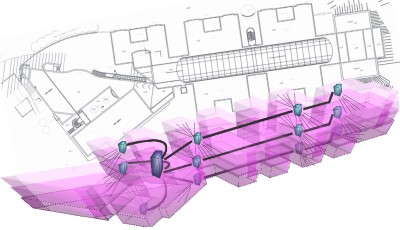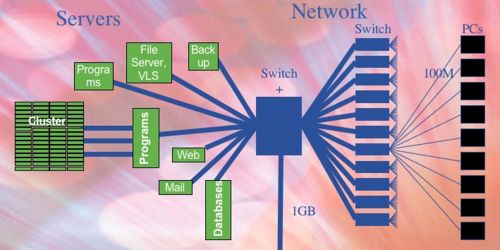Network
From Wiki CEINGE
All the CEINGE areas are provided with wired and wireless internet connectivity, allowing internet access to all laboratories, service areas and offices; the wired connectivity is distributed by using Gbit fibers from one central area of the building to all peripheral areas and can be summarized as follow:
- Central network;
- Peripheral network;
- External connectivity;
- Client connectivity;
- Wireless network.
- Central network: One central network node provides connection to the peripheral nodes and connectivity to the internet; it is located in the server room where all the computing servers can connect redundantly to it by using ethernet connectivity up to 2 Gbit/s.
- Peripheral network: 12 network nodes are distributed homogeneously in the building and provides ethernet connection to the clients; each network node can be configured to offer different virtual LAN, allowing client grouping and low level isolation between groups of computers, for security and network manageability.
- External connectivity: it is realized by a connection hosted by the close Faculty of Medicine, to the central network of the University of Naples Federico II, that allow direct access to the research network (GARR) through a fiber uplink at 1Gbit/s.
- Client connectivity: the desktop clients need to be equipped with a fast ethernet card and properly configured by the system administrator according to the assigned VLAN. The IP configuration is managed by the system administrator and can be required by using the online Helpdesk form.
- Wireless network: All the main areas are covered by wireless connection and allow access to the internet at 54Mbit/s according to the 802.11g standard. See in detail how to configure it.
Network services
Almost all network services work transparently to the user but are needed to guarantee the correct functionality of a complex network architecture, offering different services and reaching appropriate levels of security. Network services can be grouped in different categories as explained in the following sections:
Servizi di base per la funzionalita' della rete e di altri servizi
- DNS
- text
- DHCP
- text
- Firewall
- text
- NAT
- text
- VPN
- text
- LDAP
- Il servizio centralizzato di gestione utenti per l'autenticazione e' stato realizzato per mezzo del sistema LDAP ed e’ stata garantita la sua integrazione con il database degli utenti ed e' utilizzato da vari server, in modo da permettere all'utente di accedere a tutti i servizi per mezzo di un singolo account personale.
Servizi di amministrazione di rete e monitoraggio
- Amministrazione remota delle macchine
- text
- Controllo di consistenza dei sistemi
- text
- Monitoraggio della rete e dei servizi
- text
- E’ garantito il controllo continuo di tutte le funzionalita’
- text
- Funzionalita’ delle apparecchiature di rete
- text
- Raggiungibilita’ delle varie aree
- text
- Disponibilita’ dei vari servizi
- text


